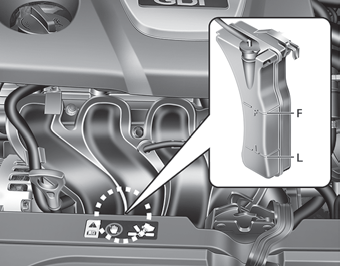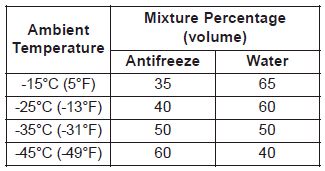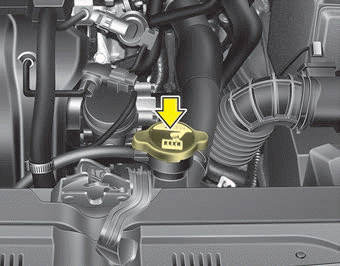Kia Rio: Maintenance / Engine coolant
The high-pressure cooling system has a reservoir filled with year round antifreeze coolant. The reservoir is filled at the factory.
Check the antifreeze protection and coolant level at least once a year: at the beginning of the winter season, and before traveling to a colder climate.
Checking the coolant level
WARNING
Removing radiator cap

Never attempt to remove the radiator cap while the engine is operating or hot. Doing so might lead to cooling system and engine damage and could result in serious personal injury from escaping hot coolant or steam.
- Turn the engine off and wait until it cools down. Use extreme care when removing the radiator cap. Wrap a thick towel around it, and turn it counterclockwise slowly to the first stop. Step back while the pressure is released from the cooling system. When you are sure all the pressure has been released, press down on the cap, using a thick towel, and continue turning counterclockwise to remove it.
- Even if the engine is not operating, do not remove the radiator cap or the drain plug while the engine and radiator are hot. Hot coolant and steam may still blow out under pressure, causing serious injury.
WARNING - Cooling fan

Use caution when working near the blade of the cooling fan.The electric motor (cooling fan) is controlled by engine coolant temperature, refrigerant pressure and vehicle speed. it may sometimes operate even when the engine is not running.

Check the condition and connections of all cooling system hoses and heater hoses. Replace any swollen or deteriorated hoses.
The coolant level should be filled between F and L marks on the side of the coolant reservoir when the engine is cool.
If the coolant level is low, add enough specified coolant to provide protection against freezing and corrosion. Bring the level to F, but do not overfill. If frequent additions are required, see an authorized Kia dealer for a cooling system inspection.
Recommended engine coolant
- When adding coolant, use only deionized water or soft water for your vehicle and never mix hard water in the coolant filled at the factory. An improper coolant mixture can result in serious malfunction or engine damage.
- The engine in your vehicle has aluminum engine parts and must be protected by an ethylene-glycol with phosphate based coolant to prevent corrosion and freezing.
- DO NOT USE alcohol or methanol coolant or mix them with the specified coolant.
- Do not use a solution that contains more than 60% antifreeze or less than 35% antifreeze. This would reduce the effectiveness of the solution.
✽ NOTICE
Make sure that the coolant cap is properly closed after refilling the coolant. Otherwise the engine could overheat while driving.
For mixture percentage, refer to the following table.


WARNING
Radiator cap

Do not remove the radiator cap when the engine and radiator are hot. Scalding hot coolant and steam may blow out under pressure which may result in serious injury.
Changing the coolant
Have the coolant changed by an authorized Kia dealer according to the Maintenance Schedule at the beginning of this chapter.
CAUTION
Put a thick cloth or fabric around the radiator cap before refilling the coolant in order to prevent the coolant from overflowing into engine parts such as the alternator.
 Engine oil
Engine oil
Checking the engine oil level
■ Gamma II 1.6L MPI (Gasoline engine)
1. Be sure the vehicle is on level ground.
2. Start the engine and allow it to reach normal operating temperature.
3. Turn t ...
 Brake/clutch fluid
Brake/clutch fluid
Checking the brake/clutch fluid level
Check the fluid level in the reservoir periodically. The fluid level should be
between the MAX (Maximum) and MIN (Minimum) marks on the side of the reservoir ...
Other information:
Kia Rio 2017-2020 YB Service Manual: Quarter Fixed Glass
Components and components location Component Location 1. Quarter fixed glass Repair procedures Replacement 1. Pull down rear door window glass by pressing the power window glass switch. 2. Remove the ...
Kia Rio 2017-2020 YB Owners Manual: Air bag non-inflation conditions
• In certain low-speed collisions, the air bags may not deploy. The air bags are designed not to deploy in such cases because they may not provide benefits beyond the protection of the seat belts in such collisions. • Air bags are not designed to inflate in rear collisions, because occu ...
